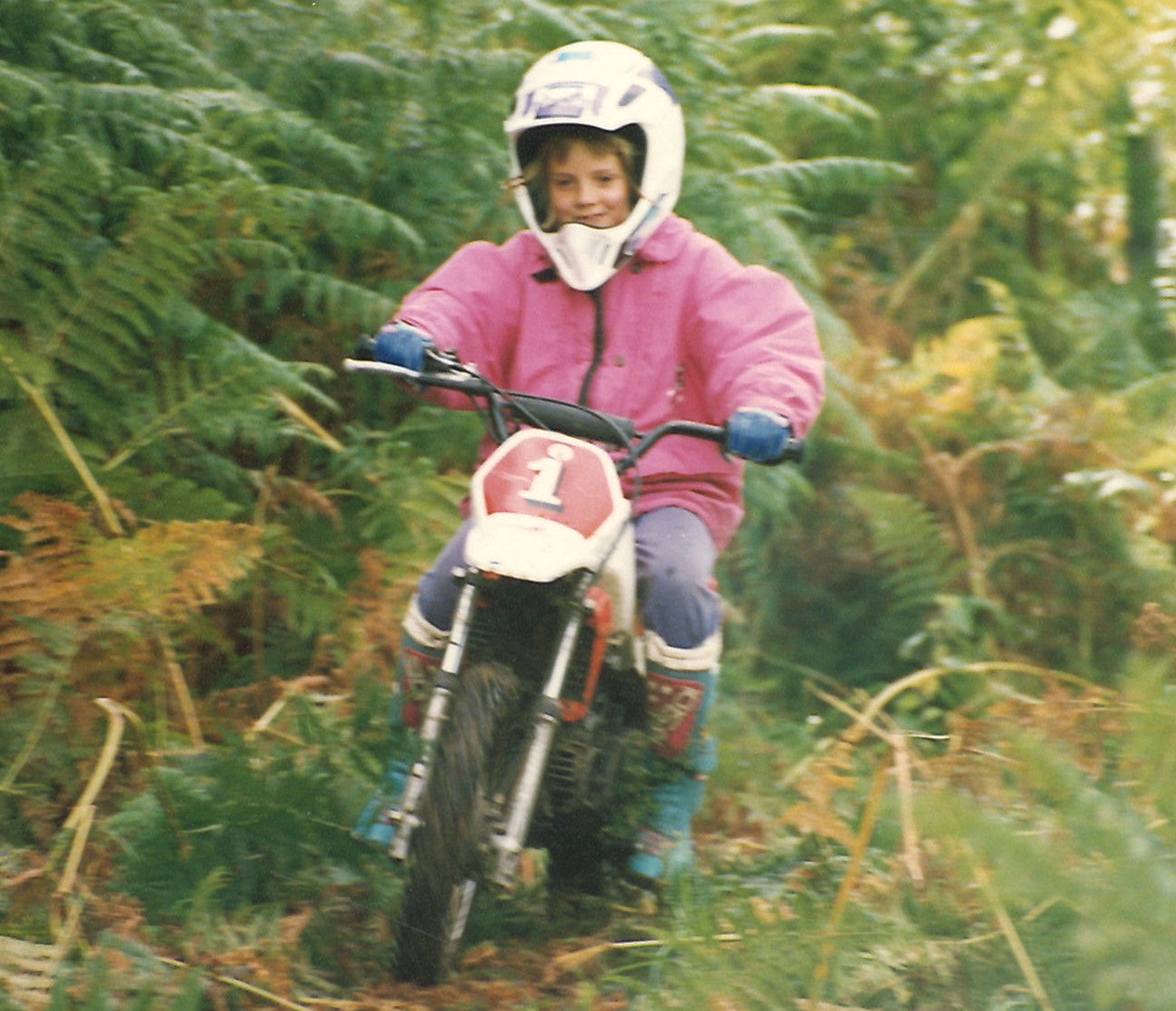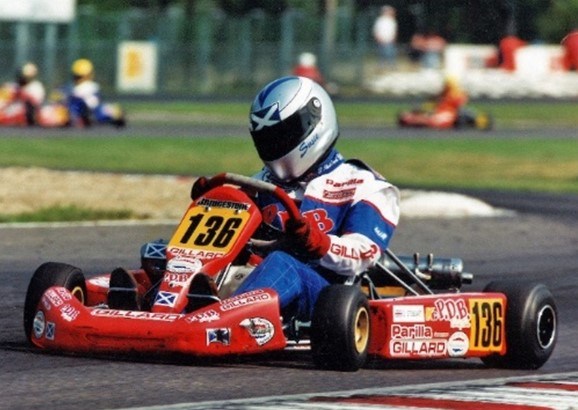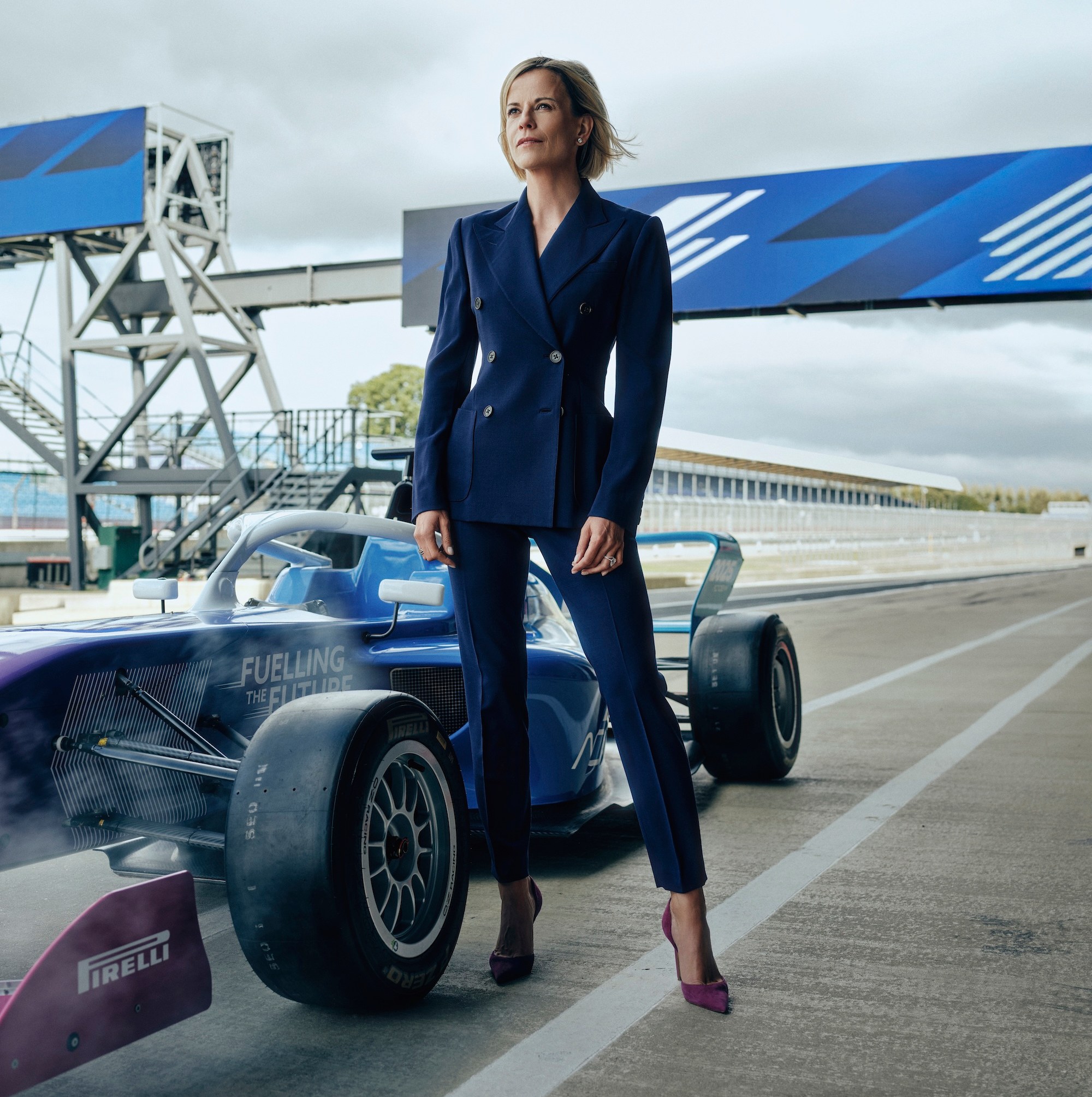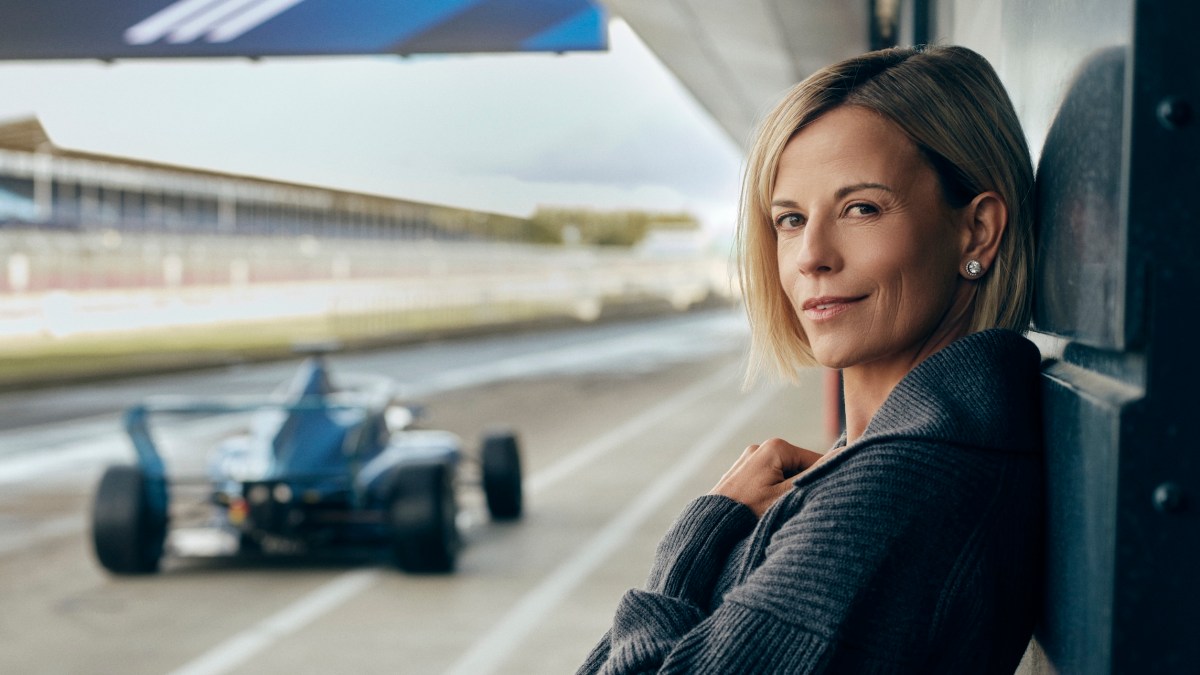Day four of testing race cars — crammed into the cockpit, G-force kneading her body — and Susie Wolff was immobilised. Lap after lap on the track had taken its toll: when she woke up she couldn’t move her neck. Crawling to the shower, she made the water as hot as she could take it and, with palms that were blistered and raw from gripping the steering wheel, she massaged the cords of muscle in her neck. Then she taped up her hands, put her helmet on and got back in the car. She was 23.
“I used to love the pain because every time I thought, well, it really hurts, that means I’m getting stronger,” Wolff says. “And I’m definitely of that old mantra, no pain, no gain.”
This is not surprising. Wolff’s two-decade racing career was an exercise in revelling in discomfort: not just the pain of pushing her body to its physical limits, but also the uneasiness of being the only woman — or “girl” — in the room, on the track and in the conversation. The Scot spent seven seasons competing in the fast and furious Deutsche Tourenwagen Masters (DTM) racing series for Mercedes-Benz. In 2012, aged 29, she became a development driver in the Williams Formula 1 team’s training programme; in 2014 she became the first woman in 22 years to take part in an F1 race weekend when she drove in a practice session at Silverstone Circuit. Two weeks later her lap time in practice at the German Grand Prix in Hockenheim was just 0.2 seconds off her team-mate Felipe Massa. Her whole career is proof that women can hack it in motorsport. “But I did end up with a tank of a neck,” she says. Needs must. “Exactly. Nothing that a scarf couldn’t hide.”
Wolff, 42, is polished, self-possessed, not a hair out of place. Despite decades spent trackside amid the din of tyres screaming on asphalt, she speaks so softly I have to lean in to hear her properly, even in a quiet corner of an empty Hilton hotel restaurant opposite Silverstone. Her accent is still west of Scotland except for a few words (“now”, “about”) that have a German inflection, the legacy of years living in Germany — and possibly the influence of her Austrian husband, Toto Wolff, the 53-year-old team principal for the Mercedes F1 team and Teutonic heart-throb of Drive to Survive, the Netflix docuseries that has introduced motorsport to a vast new global audience.

Behind the wheel of an F1 car for a practice lap at the 2014 British Grand Prix at Silverstone
WENN
Susie Wolff retired from driving in 2015 and since 2023 has headed up F1 Academy, a junior women’s racing series that she hopes will one day get another woman into an F1 car (it also has its own Netflix series, F1: The Academy, which premiered in May). She is about to publish her autobiography, Driven, a love letter to motorsport, Toto and her family, and a blunt account of competing in a male-dominated sport whose brand was pure machismo.
As well as explaining how she used to race at speeds of more than 180mph, she recounts surreal moments such as the time she worked as an instructor at a Bedford driving circuit and shared a car with Prince William, racing against his brother. (Harry had the raw speed; William was more methodical and ended up narrowly beating Harry’s best lap time.)
Her career was dominated by occasions where she was reminded she was different. Competing in Formula A, karting’s top level, she had to suffer in silence in a rib protector — which is meant to cushion the driver’s body from intense force — not designed for a female torso. When she arrived for her testing session for the DTM series, a Mercedes rep asked whether she was “in marketing, hospitality or catering”. On joining the Mercedes team, she arrived in Düsseldorf for the annual DTM showcase and was thrilled to see her face on posters lining the streets — but when Audi signed a female driver, DTM proposed a photoshoot with them squaring off like boxers in a ring (they refused). One season Mercedes put Wolff in a pink car.
Much of the time her experiences were bruising; and once she was frightened. In 2007 Wolff attended a lavish Hugo Boss Christmas party to celebrate the fashion brand’s sponsored athletes. It was “great fun” but Wolff didn’t drink, so when the party decamped to the hotel bar she retired to bed. At about 2am her room phone rang: on the line was “one of the most powerful men in Formula 1”. He was drunk. She hung up. He called again and asked for her room number. “I forced a laugh, light, dismissive,” she writes. “No, no, don’t come to my room. I put the phone down.” When it rang again she yanked the cord from the wall. The next moment he was knocking at her door and trying the handle.
“What am I going to do if that door opens? I couldn’t think of anyone I could call to help me,” she recounts in the book. “I mapped the room. The wardrobe. The door to the stairwell. If he managed to force his way in, I’d slip into the wardrobe, wait, and the second I had an opening I’d run.” The knocking stopped but she still couldn’t sleep. Wolff waited until the crack of dawn and fled the hotel.

With her husband, Toto Wolff, and their son, Jake
JAMES WARREN
The man later apologised. But it was “terrifying because of the huge power the other person had”, she says now. “There are situations we find ourselves in as women where a split-second decision can have a huge impact on your life. I would hope that now a woman could turn around and say, ‘This happened to me and it was truly terrifying,’ and that they would be listened to. I do think the sport has come a long way. It doesn’t mean that we’ve not got more work to do.”
Motorsport is still navigating complicated power dynamics. In February 2024 the Red Bull principal and CEO, Christian Horner, was accused of inappropriate behaviour by a female colleague. Screenshots of alleged WhatsApp messages between the two were leaked. He was twice cleared of the claims, first by an internal investigation conducted by a lawyer and then by another lawyer who dismissed the complainant’s appeal. In July Horner’s 20-year career at Red Bull ended when he was sacked amid poor performances. Last month it was reported that Horner had been awarded an £80 million payout.
Wolff says it has taken a dogged tenacity to get ahead in motorsport: “My brother says, ‘If you set your sights on something, there’s nothing right, there’s nothing left, it’s only that.’ He also says, ‘You miss so much of life because if you look right and left there’s so much more to see.’ Which is true. It’s just part of my character.”
Born Suzanne Stoddart in Oban on Scotland’s wet, windy west coast in 1982, Wolff had a wild childhood driving mini-motorbikes up hills and riding jet skis on water so cold it stung. “I grew up in an environment where you needed grit,” she says. Wolff has engine oil in her veins — her maternal grandparents ran a motorbike shop in Derbyshire; her dad’s dad was an engineer for Rolls-Royce; and her father, John, was a mechanic who owned a motorbike shop in Oban, where he met her mother, Sally, when she came in to buy one. “My mum raced bikes. And you don’t think about that as an eight-year-old, but clearly that had a huge impact on me. Well, if she can do it, there was never a question for me.”

Wolff rode motorbikes as a child in Oban on the west coast of Scotland
COURTESY OF SUSIE WOLFF

She took up kart racing at the age of eight
COURTESY OF SUSIE WOLFF
Wolff, who was also a competitive swimmer and debater, started go-karting when she was eight and soon set her sights on F1. By the age of 12 the family’s weekends revolved around kart racing, sleeping in a truck with her parents and often making the return journey home late on a Sunday night. “By Monday morning we’d be rolling into Oban just before the bell, changing into our school uniforms in the truck, hopping out and heading straight to class,” she writes.
As a teenager her bedroom walls were plastered with posters of the Scottish F1 driver David Coulthard; instead of Just Seventeen she pored over Karting Magazine hoping to spot her name in a race report. She never felt she was missing out on the teenage rites of passage, though her parents were occasionally worried. “I will never forget my mum and dad buying me a Clinique make-up set for my 16th birthday,” she says. “They were, like, ‘You can try wearing make-up.’ ”
There were other consequences of hitting puberty. By her mid-teens, “if I passed a boy on the track, it was like flipping a switch”. After one rival launched her kart into a tyre wall, she swapped her pink racing suit for a blue and silver one. She was furious whenever her gender was raised as a point of difference, such as when she was crowned top female driver at the Karting World Championship, aged 16. “I was there to try to win but was being singled out as different.”
After leaving Oban High School with “very good” grades, she spent a miserable few months at Edinburgh University studying business before dropping out, unable to stop dreaming of motorsport. Her parents told her she needed a plan, so Wolff made her way to Silverstone Circuit in Northamptonshire, working a string of jobs while making a name for herself in motor racing’s entry-level series.
Aged 20 she was competing at Snetterton Circuit in Norfolk in the Formula Renault series alongside Lewis Hamilton (Wolff finished third, Hamilton first). On the podium Hamilton helped her open her bottle of champagne so she could join in the celebrations.
• Lewis Hamilton: Male-dominated F1 sending bad message to women
A bad ankle break briefly threatened to write off her career, the only time she has ever wondered if she had made the wrong decision. “Well, if it’s not racing, what is there?” she says. “Because I’d put it all in. But I just had this unwavering belief that you keep going.”

In the paddock with Lewis Hamilton at Circuit of the Americas in Austin, Texas, for an F1 Academy race, 2023
GETTY IMAGES
It paid off: aged 23, Wolff was called up to test-drive for the Mercedes-Benz DTM team. She got the job and her life changed overnight. A brand-new Mercedes-AMG C63 turned up in her driveway in Northampton. She was invited to help herself from rails of Hugo Boss clothes. When her first pay cheque landed in her bank account she drove to the nearest ATM to goggle at the number on the screen. She had made it.
Except it was lonely. Wolff ruled out romantic relationships with any drivers for fear of risking her credibility and was terrified of opening up to colleagues or rivals. “I felt I couldn’t show any weakness because I was being judged as the only girl there, and that would be another negative next to my name of why I didn’t deserve the chance,” she says. There was no instruction manual for being a woman in the sport. “I felt if I wore a dress people thought I was trying too hard and I was there for the attention. If I didn’t wear a dress, ‘Oh, she can’t really represent the Mercedes-Benz brand because she looks like a man.’ ”
• When will we finally see a woman driving a Formula 1 car again?
Then, while driving in DTM, she met Toto. She first clocked the racing driver turned investor — who co-owned the Mercedes team — at a race in Nuremberg (“he was tall, dark and incredibly handsome”). Toto knew her name, but was surprised to learn she was now driving in his team. He was cocksure and confident — and, when they met, dating Miss Austria. Months later he messaged her on Facebook, and before long they were together, a love affair that he has described as a “coup de foudre”.
“It just happened so quickly because we were on the same wavelength,” she says. “I could be me, unfiltered, and he understood that. That felt like a weight off my shoulders.” Used to control, she now enjoyed surrendering to their romance. “I had no problem to completely let go because I had so much trust in him and so much confidence in how well we fit.”

SANE SEVEN FOR THE SUNDAY TIMES MAGAZINE. HAIR: EMMA LEON. MAKE-UP: SARAH DOHERTY ASSISTED BY JORDAN HENRIQUES STYLIST: VICTORIA BAIN. SUIT BY RALPH LAUREN, SHOES BY MANOLO BLAHNIK
Eight months in, he proposed on a boat in Venice, and they married on the Italian island of Capri in 2011. After the wedding she told Mercedes she’d be changing her name from Stoddart to Wolff, to the marketing department’s displeasure. “ ‘You can’t change your name, you’re the strong woman.’ No, no, no, no. I’m not on my own any more, I’m a Wolff. I’ve got someone on my side who’s part of my team,” she says.
The Wolffs live in Monaco and have a son, Jack, eight, who is a keen karter (Toto also has a son and a daughter from a previous relationship). Drive to Survive, now in its seventh season and watched by more than 6.8 million people, has turned the couple into stars. Especially her husband — the show has inspired a sort of Totomania. At one point “we landed in Miami and all these people were at the airport. A lot of them were young girls.”
The show depicts the internecine conflicts between the F1 teams. “It definitely took the drama that happened in the sport — which is always political — and opened it up,” Wolff says. “It wasn’t just about the cars and what happened out on track any more.” The four-time champion Max Verstappen and the British driver Lando Norris have both criticised the show for hamming up its storylines. Wolff agrees the series can overdramatise, “100 per cent. But we need people to sit down and enjoy consuming Drive to Survive or a Formula 1 race. That means it needs to be entertaining. And that means, yes, you need to get the drama.”
On the subject of drama, her husband’s rivalry with Horner is a Shakespearean storyline that formed the show’s backbone. How did Wolff feel when she heard Horner had left the paddock? “Christian was supportive of F1 Academy, and for that I’ll always be grateful,” she says. “It was a real shame for the sport — the whole drama that was created with the allegations. We were getting so much positive momentum with F1 Academy, and that all kicked off and suddenly everyone wanted to interview me about that. He was someone that played a character very well. But I do think that incident maybe wasn’t the best for the image of the sport and showed that we’ve still got work to do.”

At an F1 Academy race in Shanghai in March with Christian Horner, the Red Bull team principal. He was sacked in July
GETTY IMAGES
In 2023 Wolff was the subject of allegations when the FIA, motorsport’s governing body, launched an investigation into whether her role at F1 Academy and Toto’s position at Mercedes constituted a conflict of interest, only to swiftly withdraw it 48 hours later. All nine other F1 teams released identical statements saying they were “pleased and proud” of the academy and that no team had filed a complaint. By that point, Wolff says, “the damage was done”. She later launched a defamation case against the FIA, calling the allegations “intimidatory and misogynistic”. The fallout is an “ongoing process”, she says. “I refused to be treated that way. It created a huge amount of articles doubting my integrity. People can have their opinions on [whether] what I do is good or not. But that’s something I won’t allow to happen, that people attack my integrity.” She was “touched” by the paddock’s support during the incident.
• Why are so many women leaving top jobs at FIA?
All ten F1 teams support the women-only F1 Academy, which competes in grands prix in seven cities. One of them is Jeddah in Saudi Arabia, where until 2018 only men were allowed driving licences. “I can only tell you that at the beginning, when I was struggling to put a calendar together, they were the first ones that came to the table,” Wolff says. “Of course there are cultural differences, but in the end they took action. They’ve supported us massively.”
Women still make up less than 10 per cent of participants in motorsport. Formula 1 is largely reliant on dynasties such as the Verstappens (Max’s father, Jos, is a former F1 driver) and rich kids (Norris’s father, Adam, has an estimated fortune of £200 million). Wolff relied on sponsorship to fund her route into the sport. Lewis Hamilton, whose father worked three jobs to support his son’s career, has been trackside at F1 Academy races to show his support. “He knows what it’s like to be the only one in the room, like I do,” she says.
Wolff has no regrets about anything she experienced on or off the track. “Zero bitterness, because as much as I had tough moments I also had people stepping in to give me chances. At a race yesterday night there were three young women on the podium and I thought, God, at 19, to stand on a podium on a Formula 1 race weekend with a Ferrari race suit on. That’s something I could only ever have dreamt of. The fact I helped to create that opportunity just fills me with pride.”
All or nothing: my 180mph F1 debut
The waiting is over: today I’m going to drive an F1 car for the first time. Driving to Silverstone, I see the clouds begin to break and will the sun to fight harder.
The paddock is a hive of activity. I head straight to the engineering truck to put on my race suit. A makeshift curtain has been set up to accommodate Williams’s first female driver. The briefing starts: I’ll do an installation lap to measure how much standing rainwater is on the track, followed by two ten-lap runs.
In the garage the sweet smell of racing fuel hangs in the air. The car has already been fired up. All eyes are on me. Can a girl handle a modern F1 car?
I press my earplugs into place and savour the stillness. From now on it will be just me and my engineer, Dom, on the radio. The mechanic fastens my seatbelts and clicks the steering wheel in place, its dense cluster of knobs and buttons in the centre.
Dom gives the signal to go; everyone covers their ears as the V8 engine roars to life, the thunderous growl reverberating through the garage and my body. I slowly release the clutch paddle and feed in the throttle, searching for the bite point. Too much throttle and I’ll spin the wheels; too little and I’ll stall. I ease the car out of the garage and into the pit lane. Well, thank goodness — the girl hasn’t stalled it.

SANE SEVEN FOR THE SUNDAY TIMES MAGAZINE. HAIR: EMMA LEON. MAKE-UP: SARAH DOHERTY ASSISTED BY JORDAN HENRIQUES. STYLIST: VICTORIA BAIN. JUMPER AND SUEDE TROUSERS BY JOSEPH. SHOES BY GIANVITO ROSSI
On the track I steadily climb through the gears. The puddles haven’t gone but the standing water has dissipated enough for it to be safe. I get the command to return to the pits. As I stop, the car is surrounded by a swarm of mechanics. Dom confirms the car will be checked over and we’ll start the first run.
Out on track again I accelerate through the gears. With each lap my instincts kick in, sharper and steadier. The nerves fade. Laps completed, I pull into the pitlane.
In the final session I have to prove I can be fast, not just avoid spinning off in the wet. Theories, simulations, hours spent memorising every braking point and cornering speed — they’ve all led to this moment.
Hurtling through Woodcote’s bend and Stowe’s sharper corner I feel my lungs pushed up against my ribcage. One G is the force of your own body weight — imagine five times that force ricocheting your head, like the fastest of rollercoasters taking the tightest turns, over and over.
I hammer down the throttle. The engine screams. Copse looms — the fastest corner at Silverstone. It’s all or nothing as downforce sucks the car to the track. Lift even a fraction and you’ll be slow. Then it’s into the gut punch of Maggots and Becketts, where the car snaps left, right, left again. The G-forces hit like a freight train. Then on to the long Hangar Straight, where I reach in excess of 300kph. I am consumed by the need to nail the perfect lap.
Dom’s voice crackles in my ear: last lap, back to the pits. Already? The car is pushed back into the garage and the exhaustion hits. My body feels heavy, my neck and shoulders throbbing. But endorphins chase away the ache. I have shown what I can do.
© Susie Wolff 2025. Extracted from Driven (Hodder & Stoughton £25), published on Oct 23. To order a copy go to timesbookshop.co.uk. Free UK standard P&P on orders over £25. Special discount available for Times+ members

